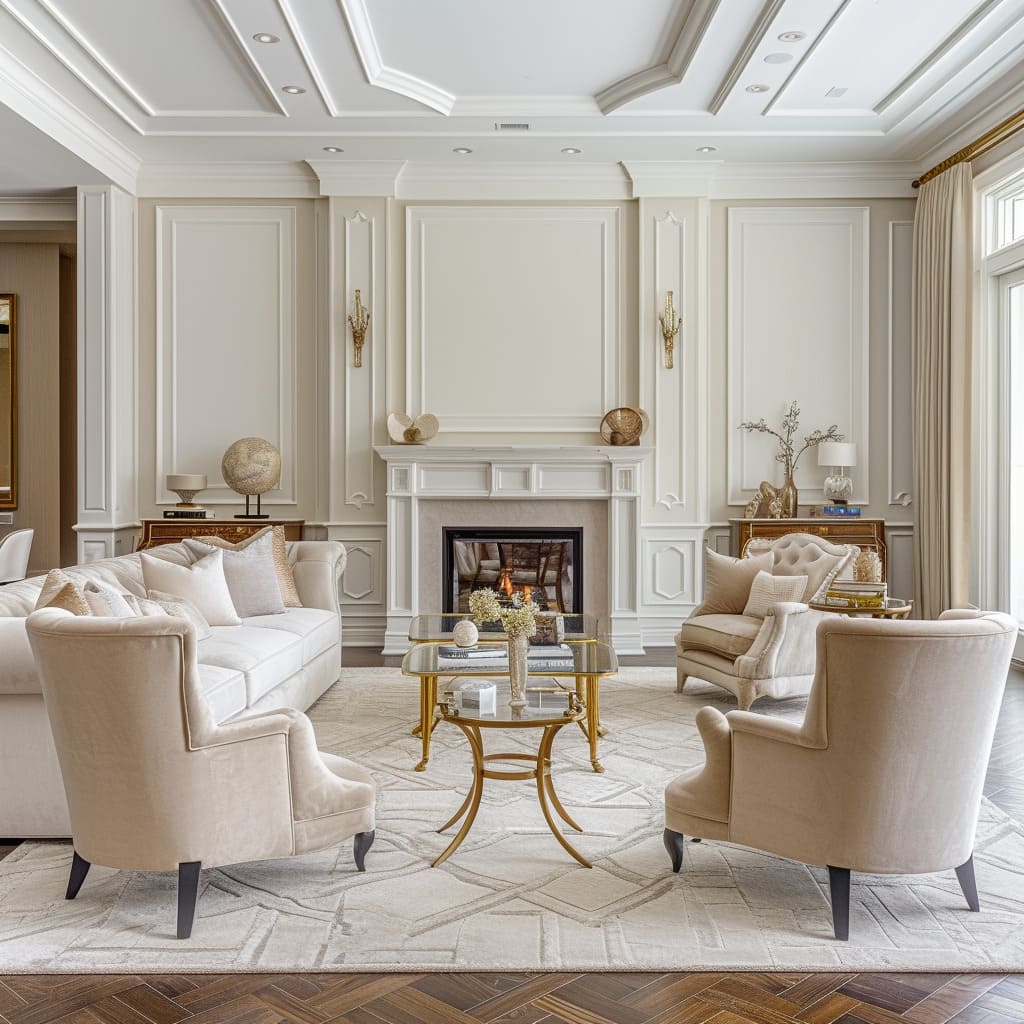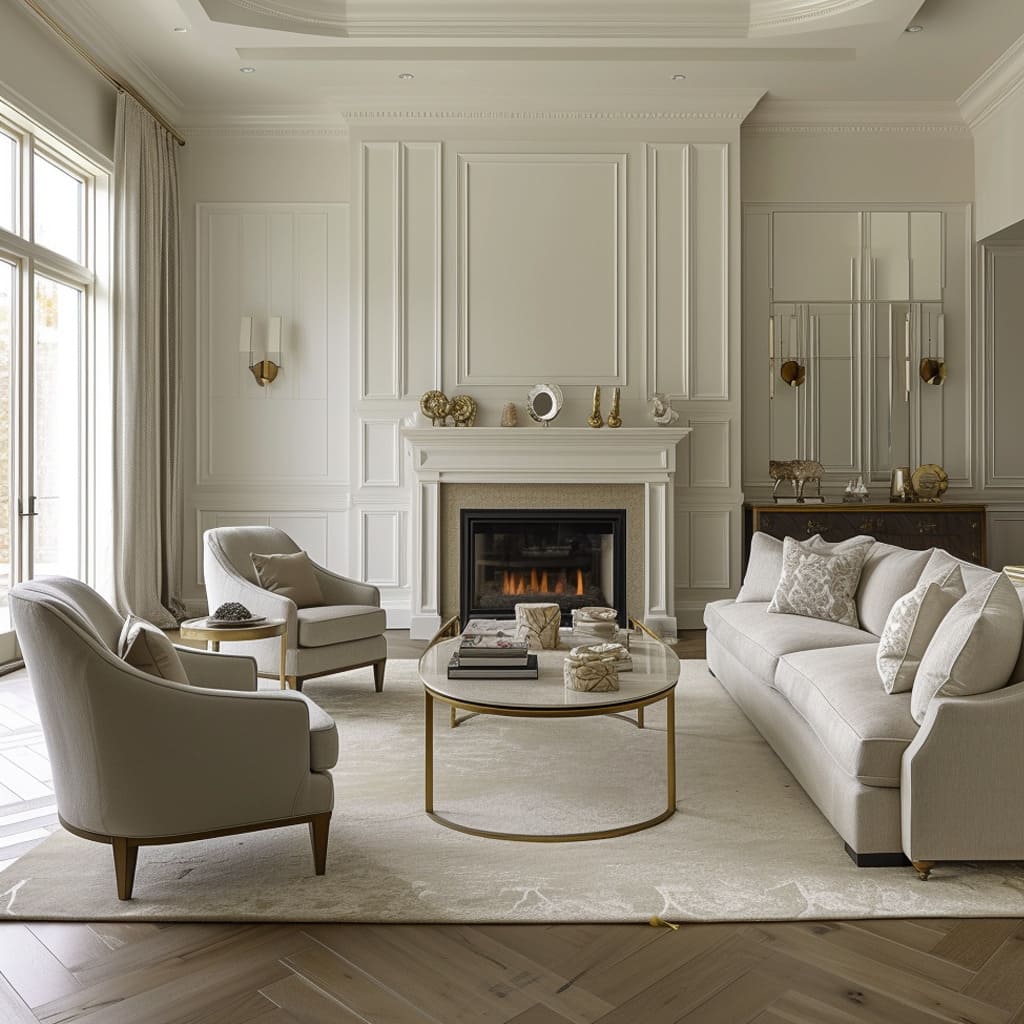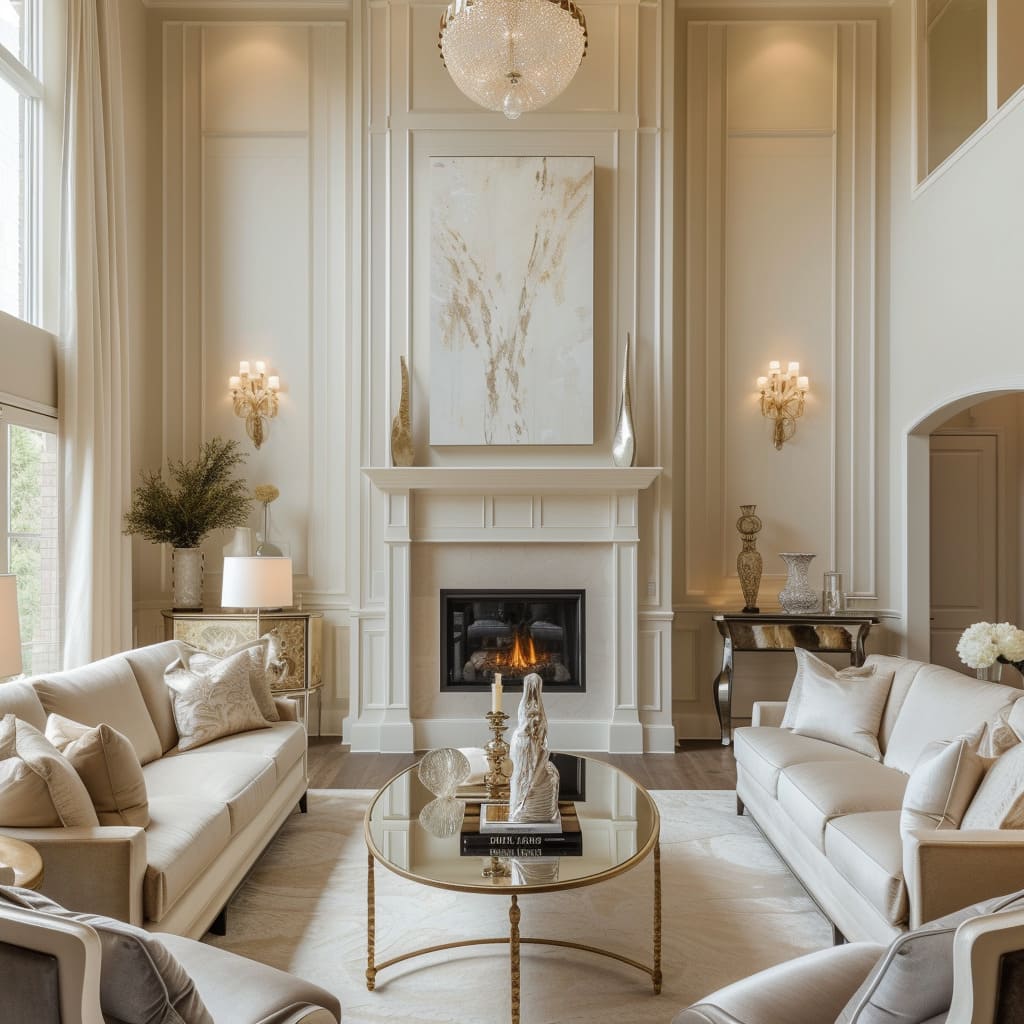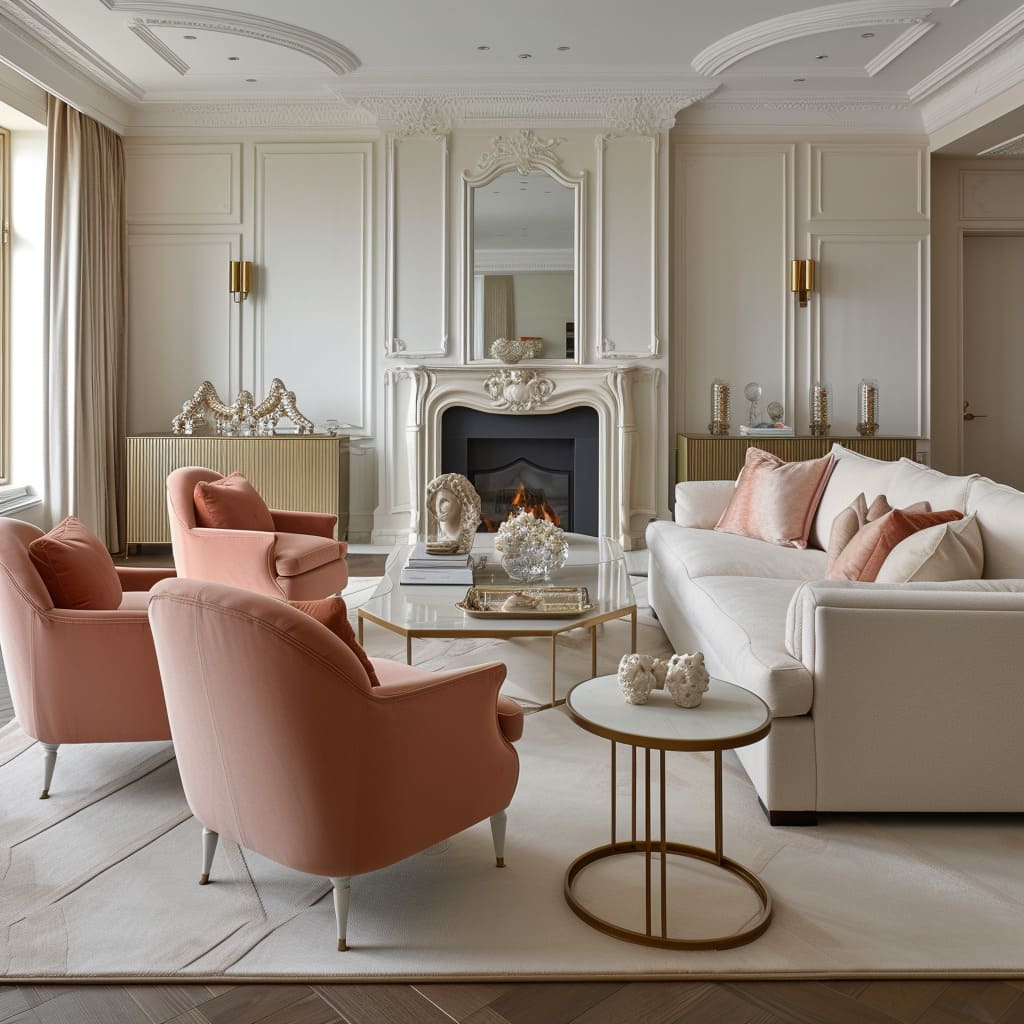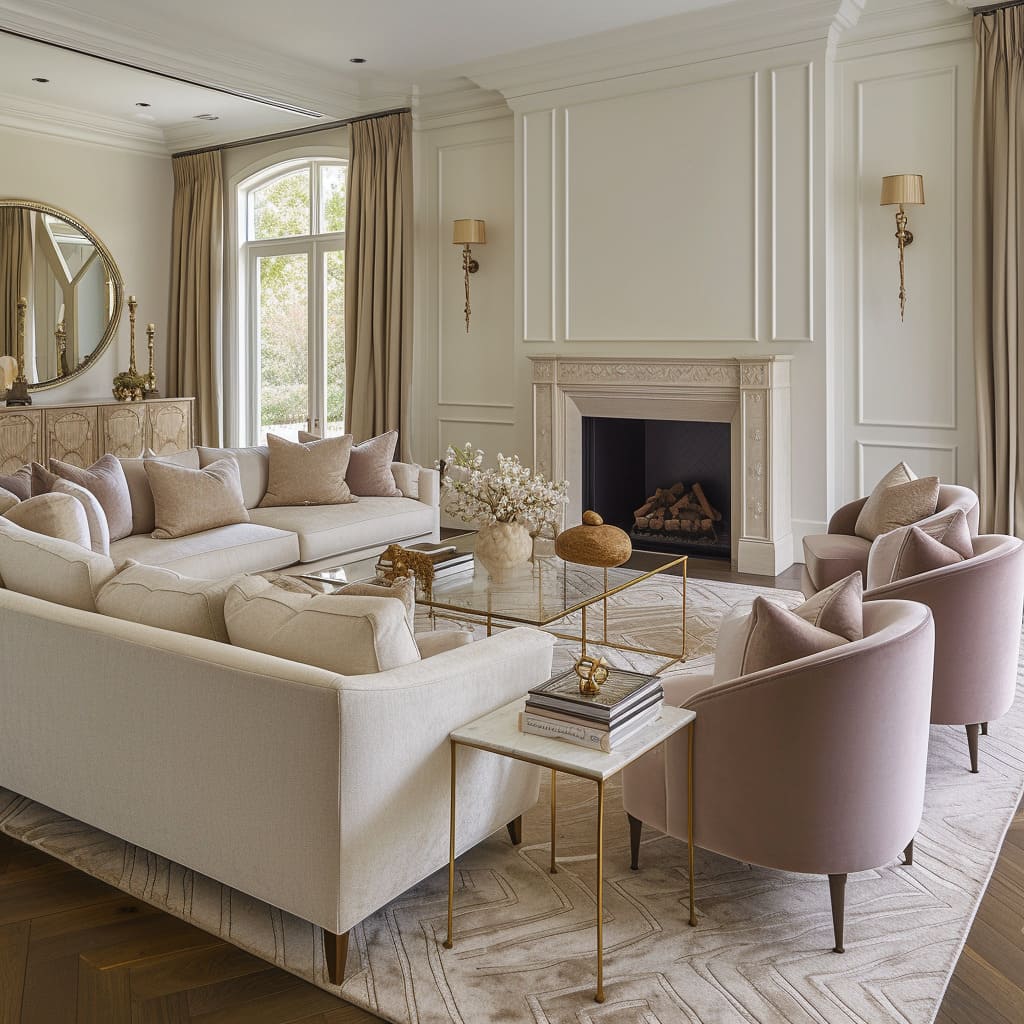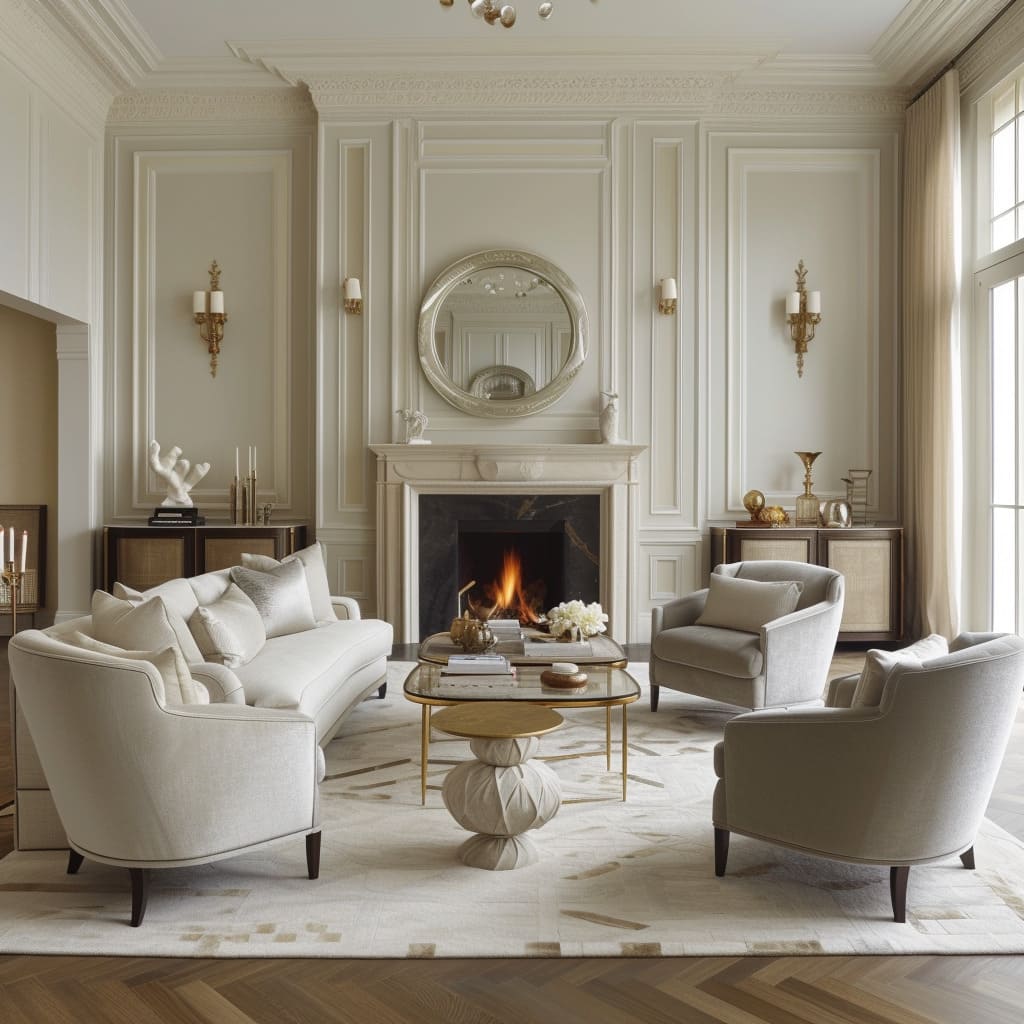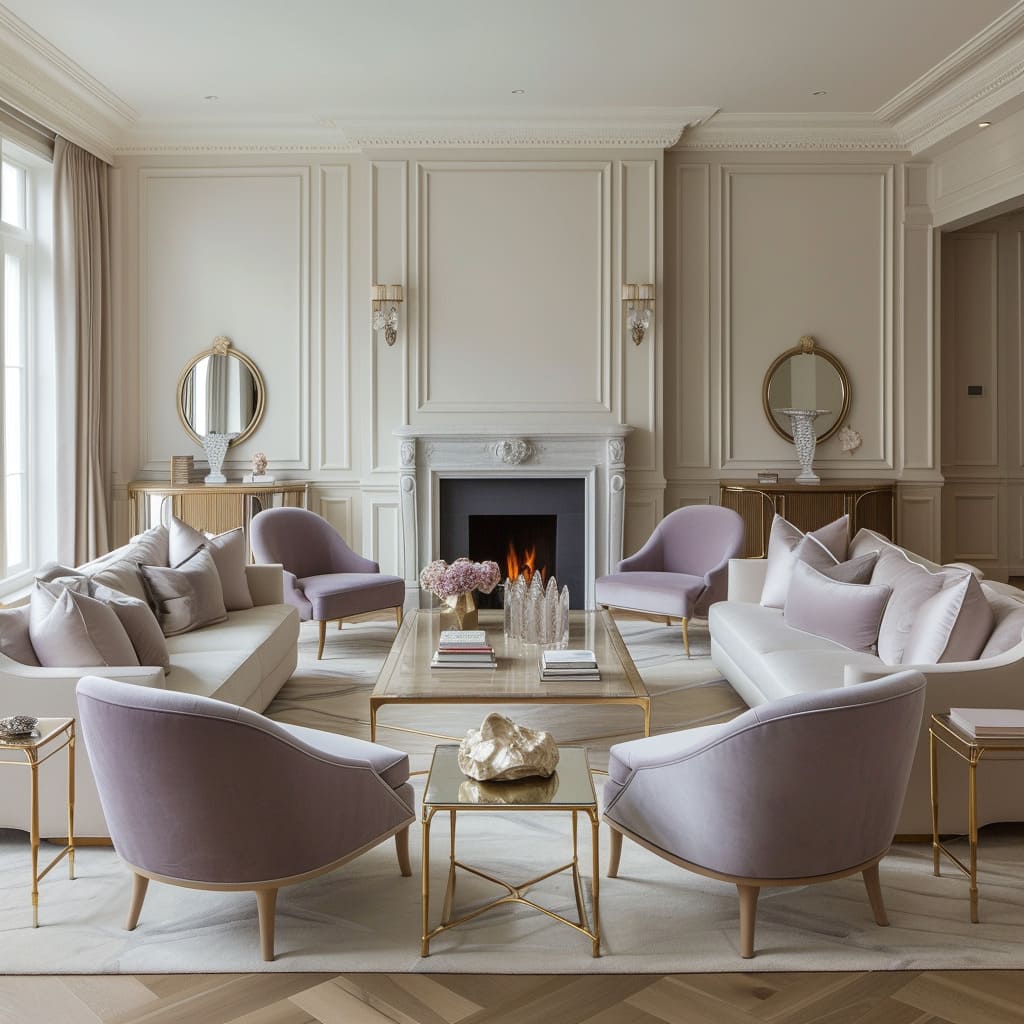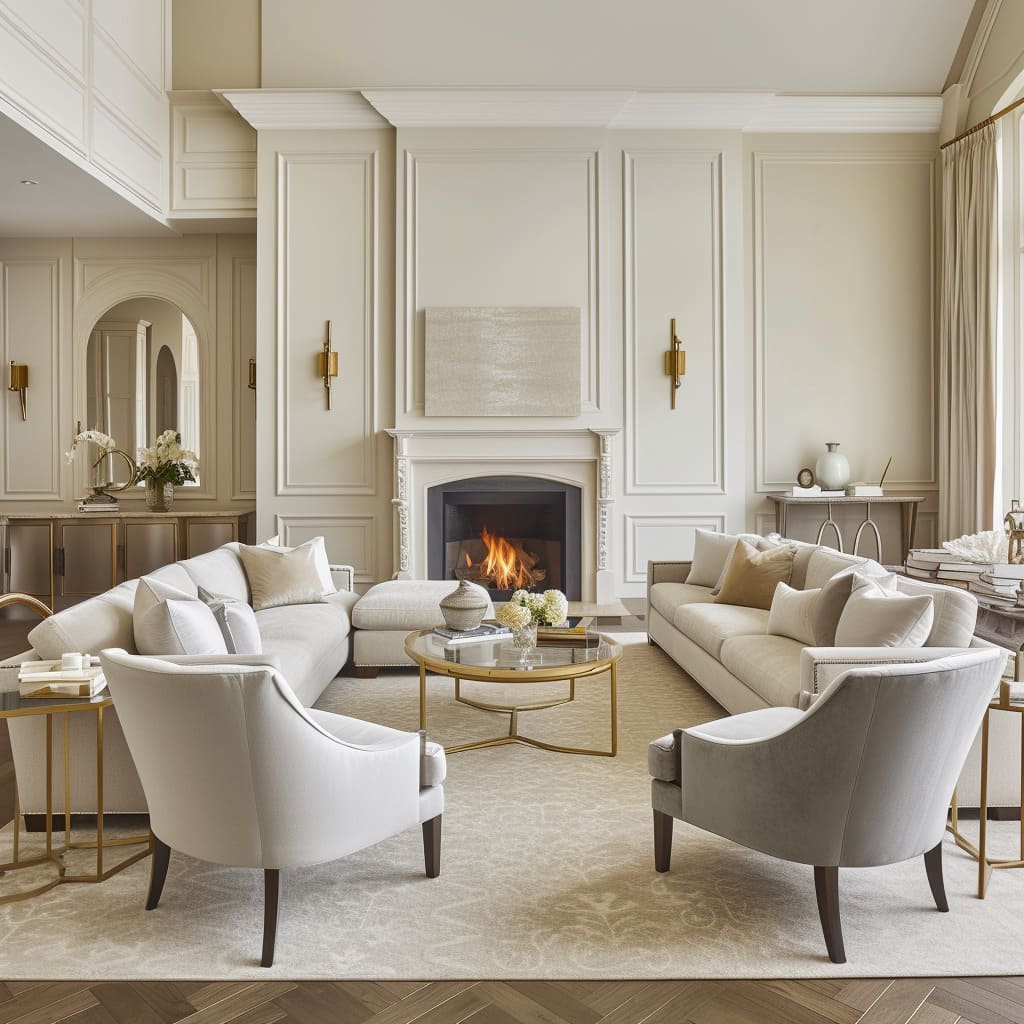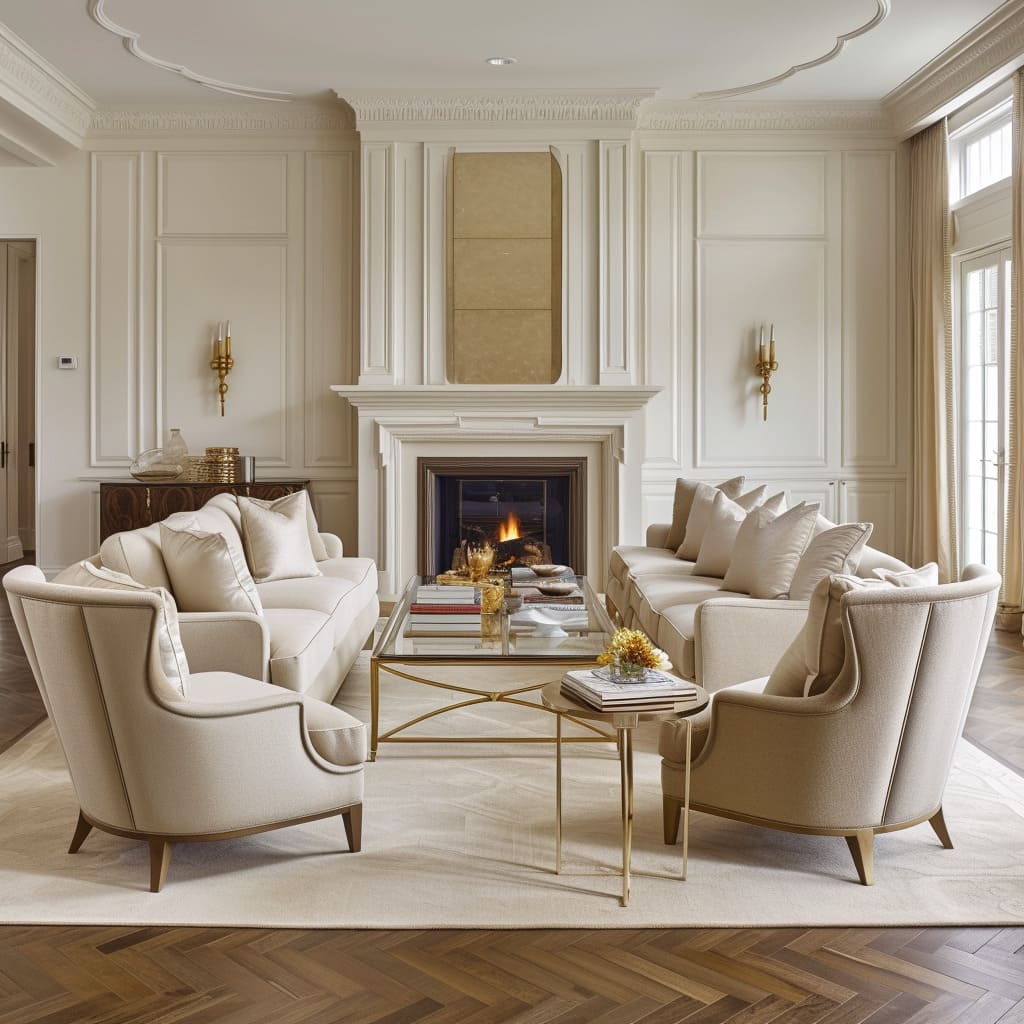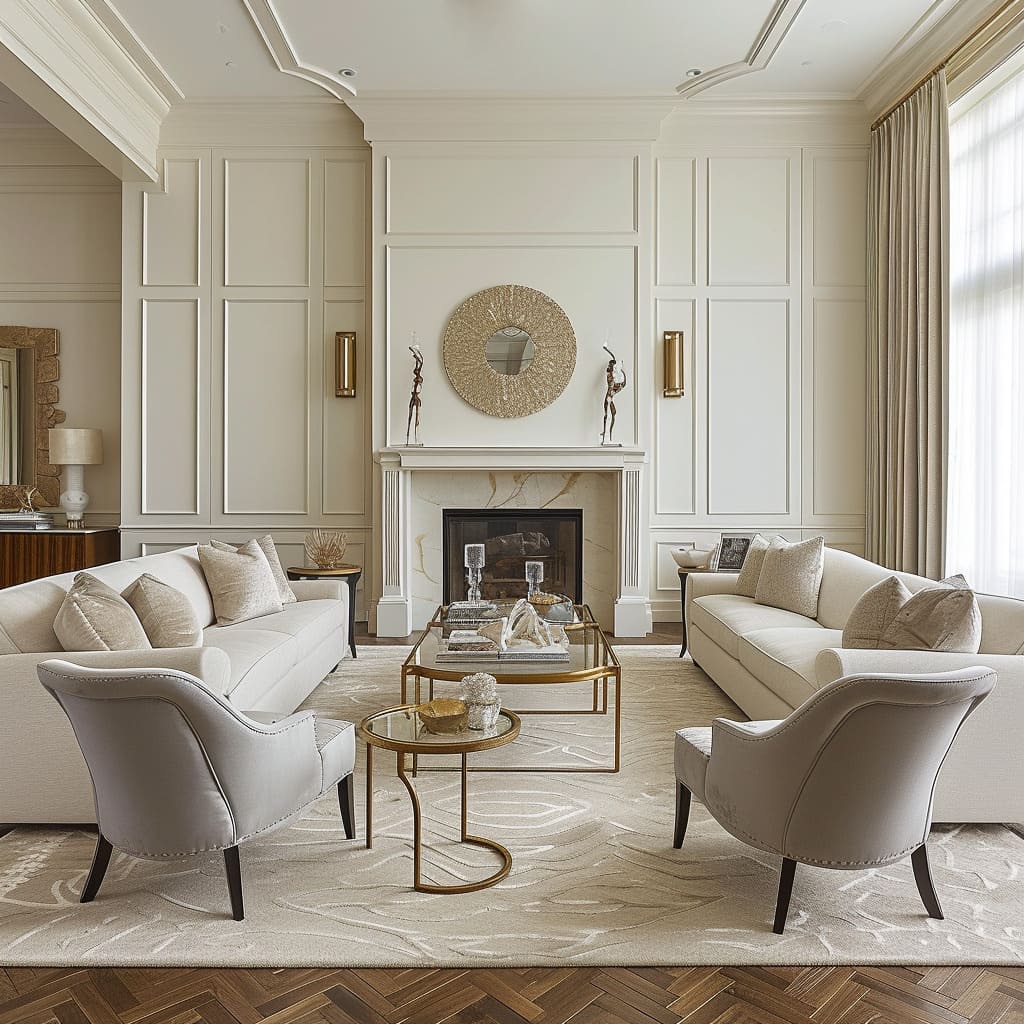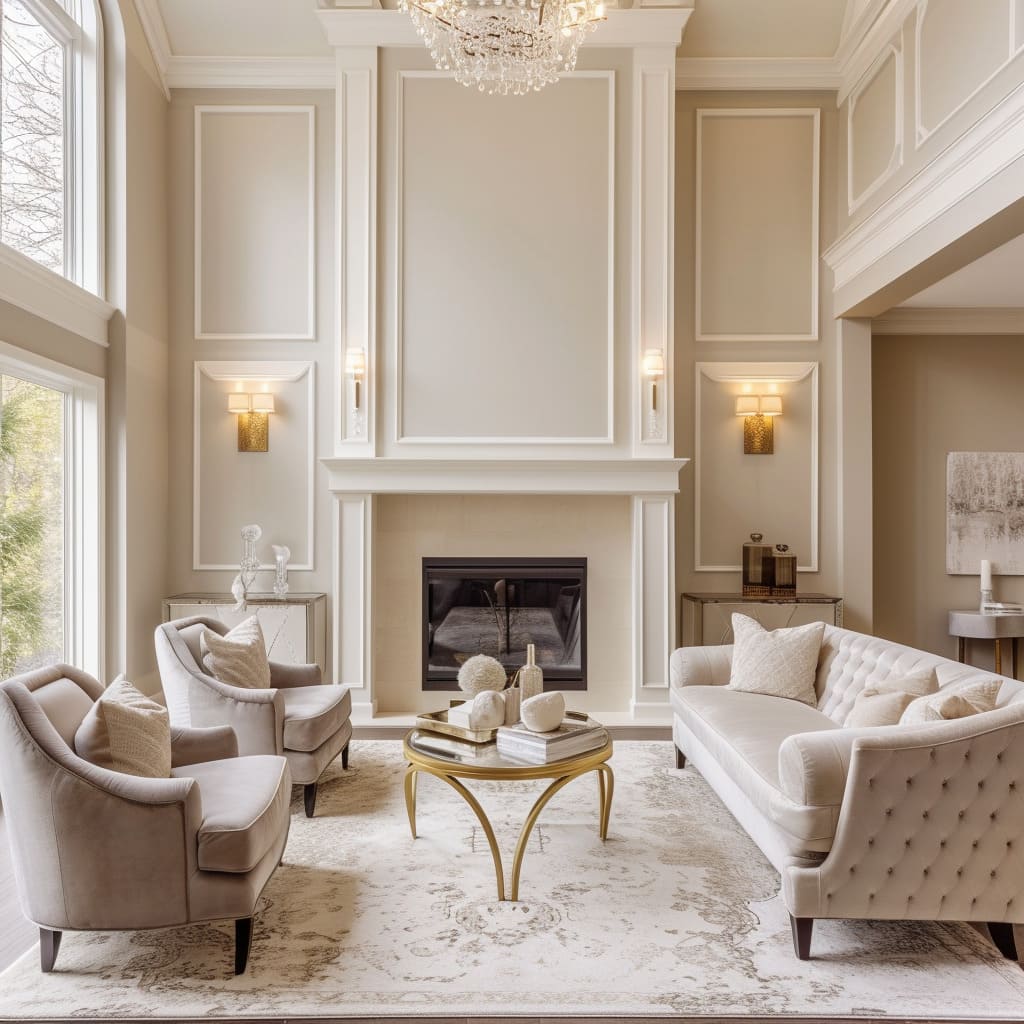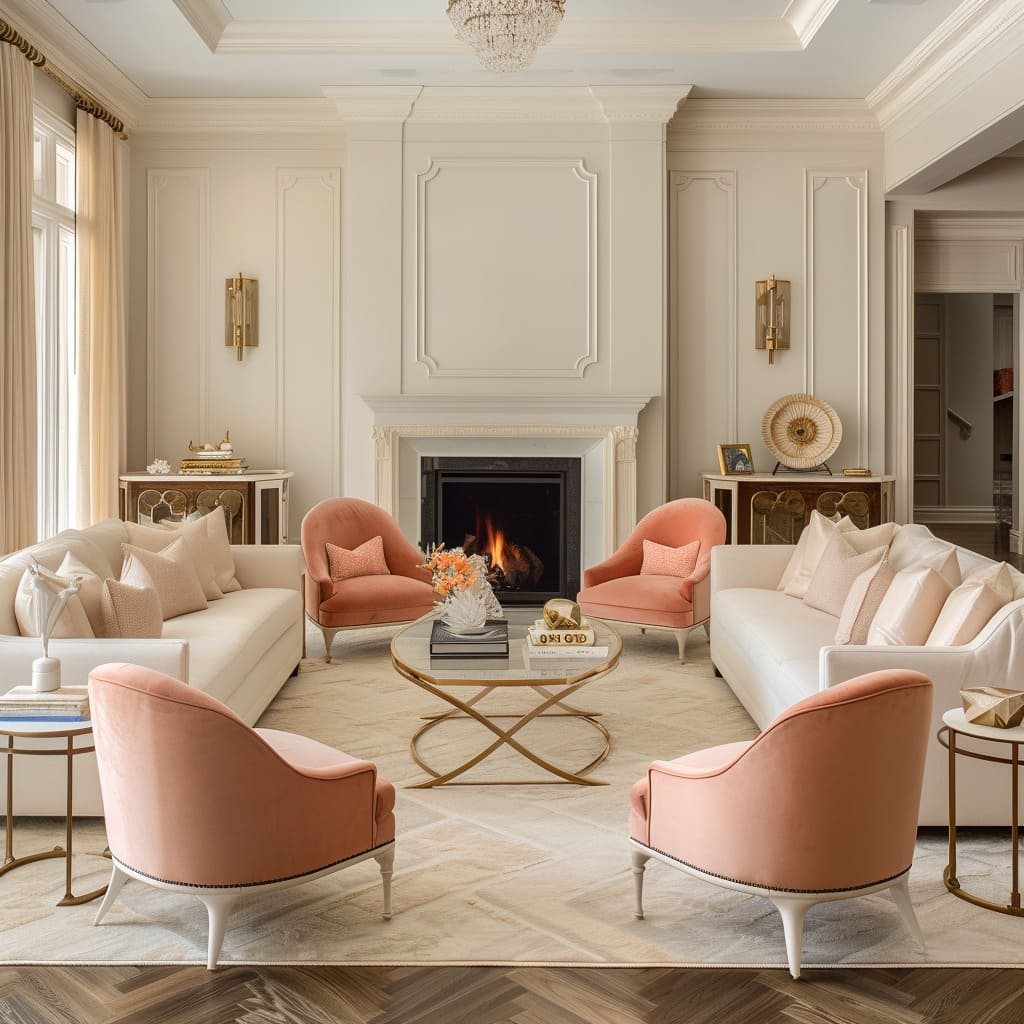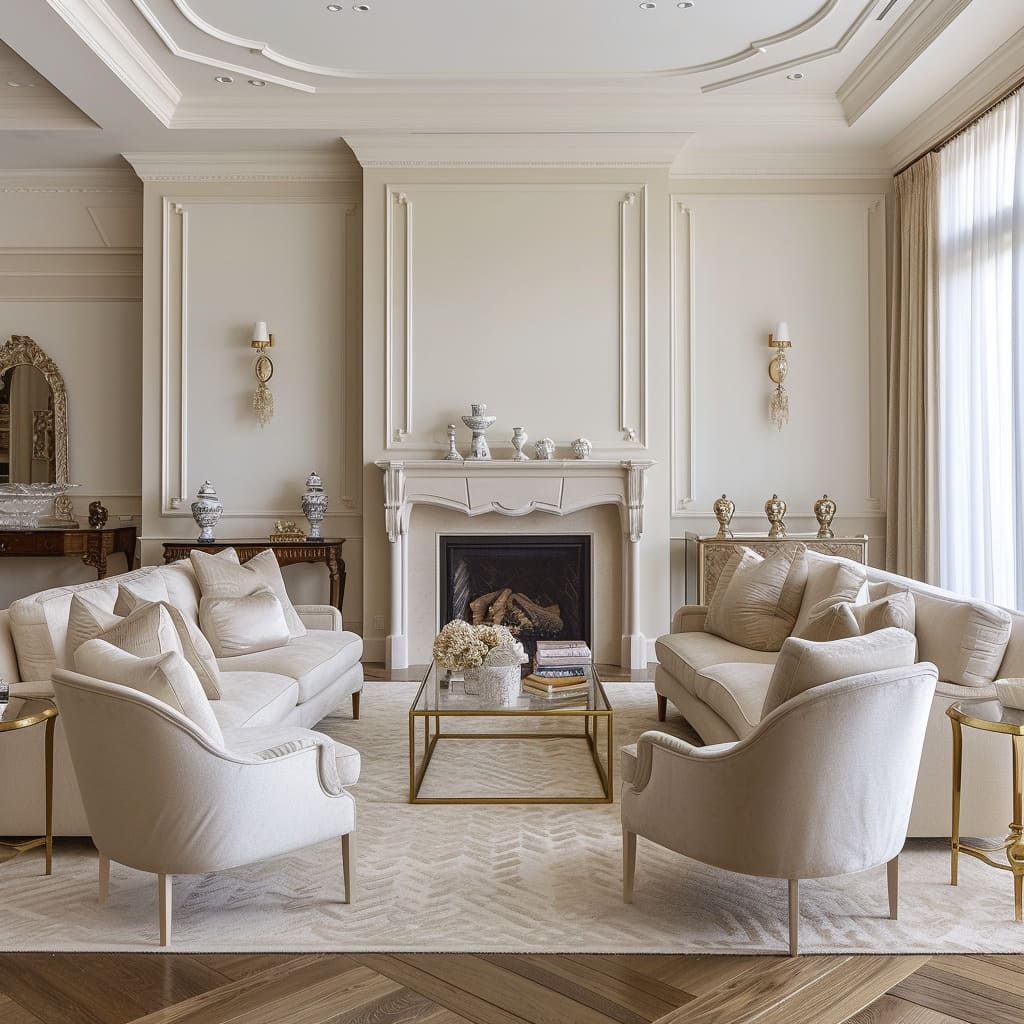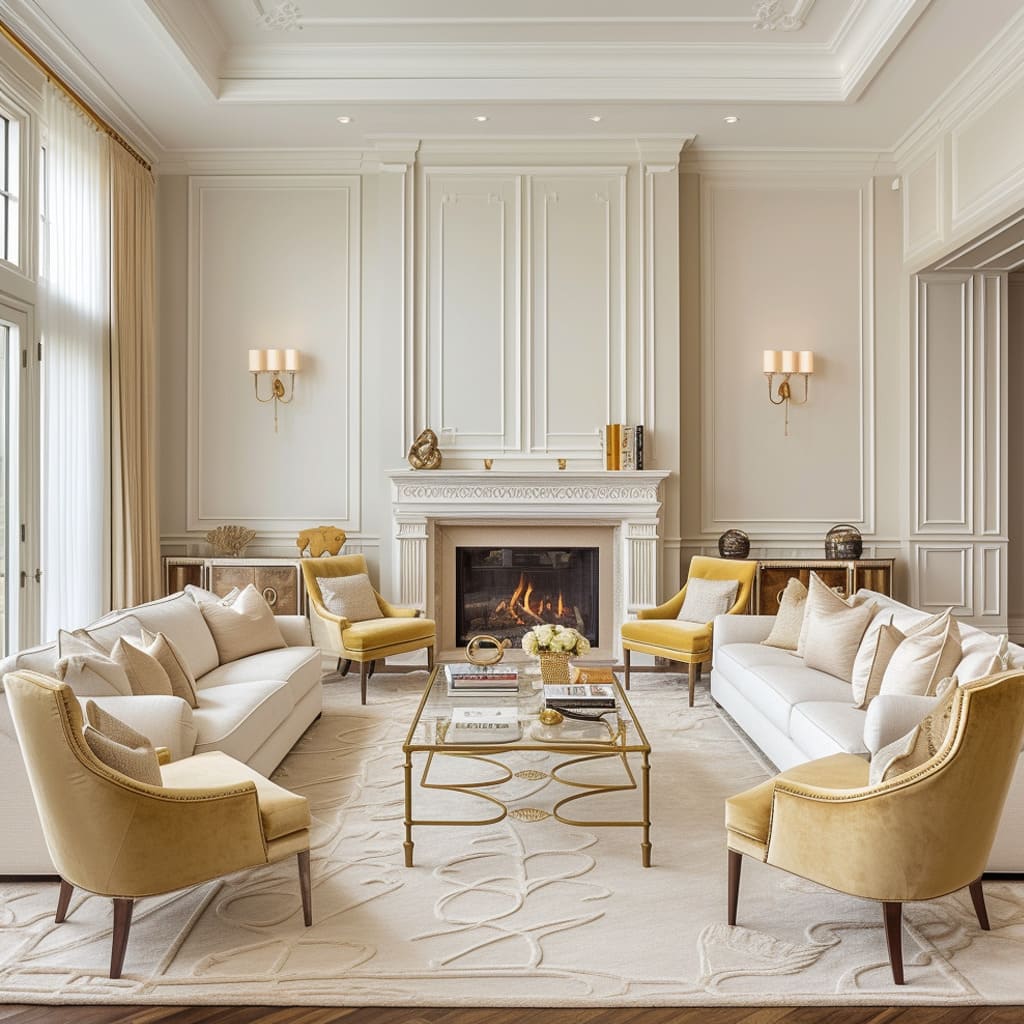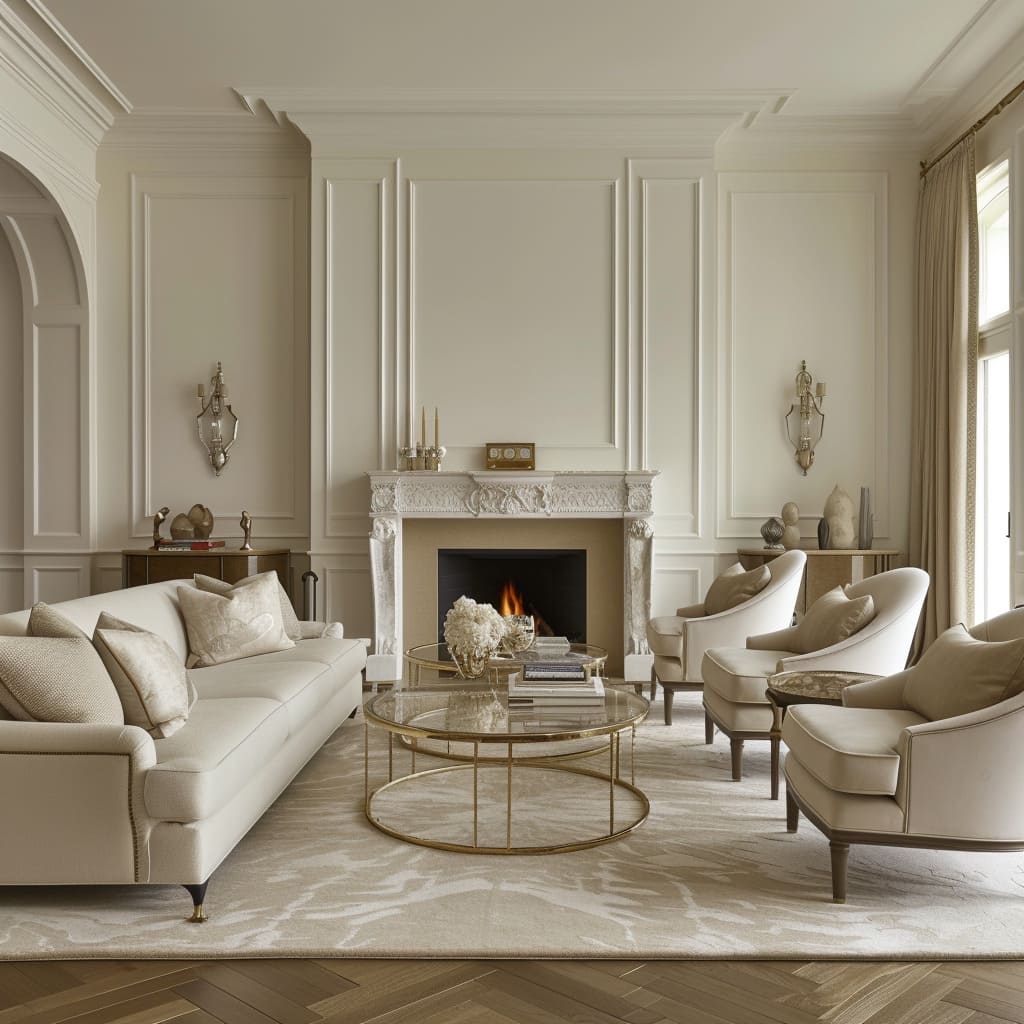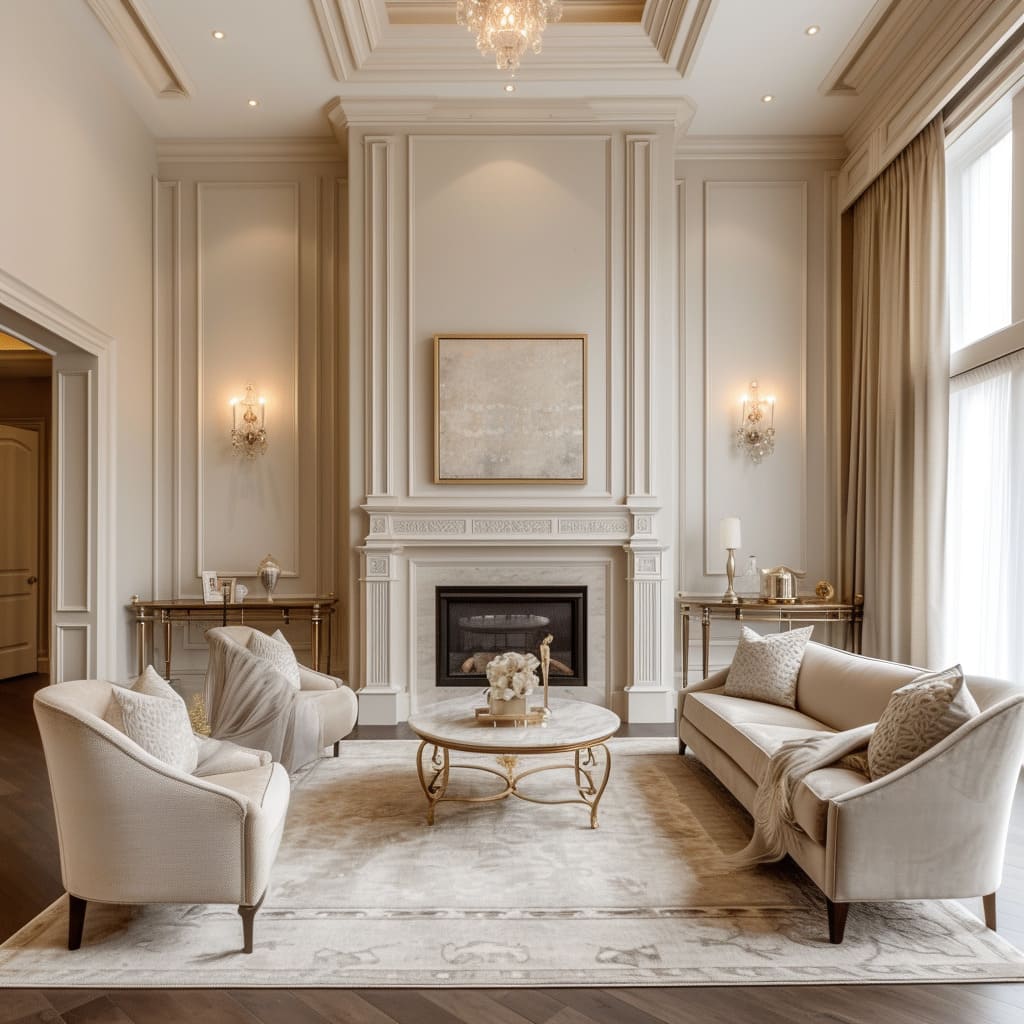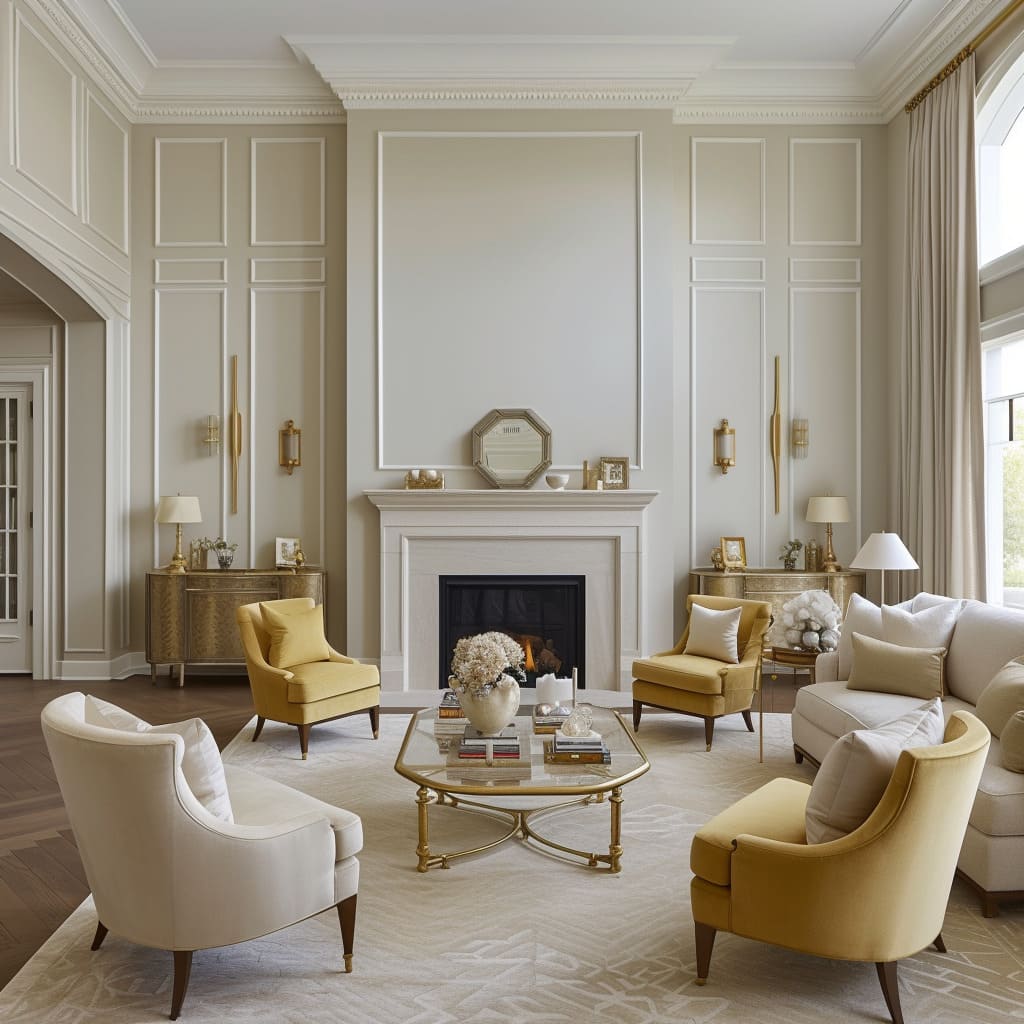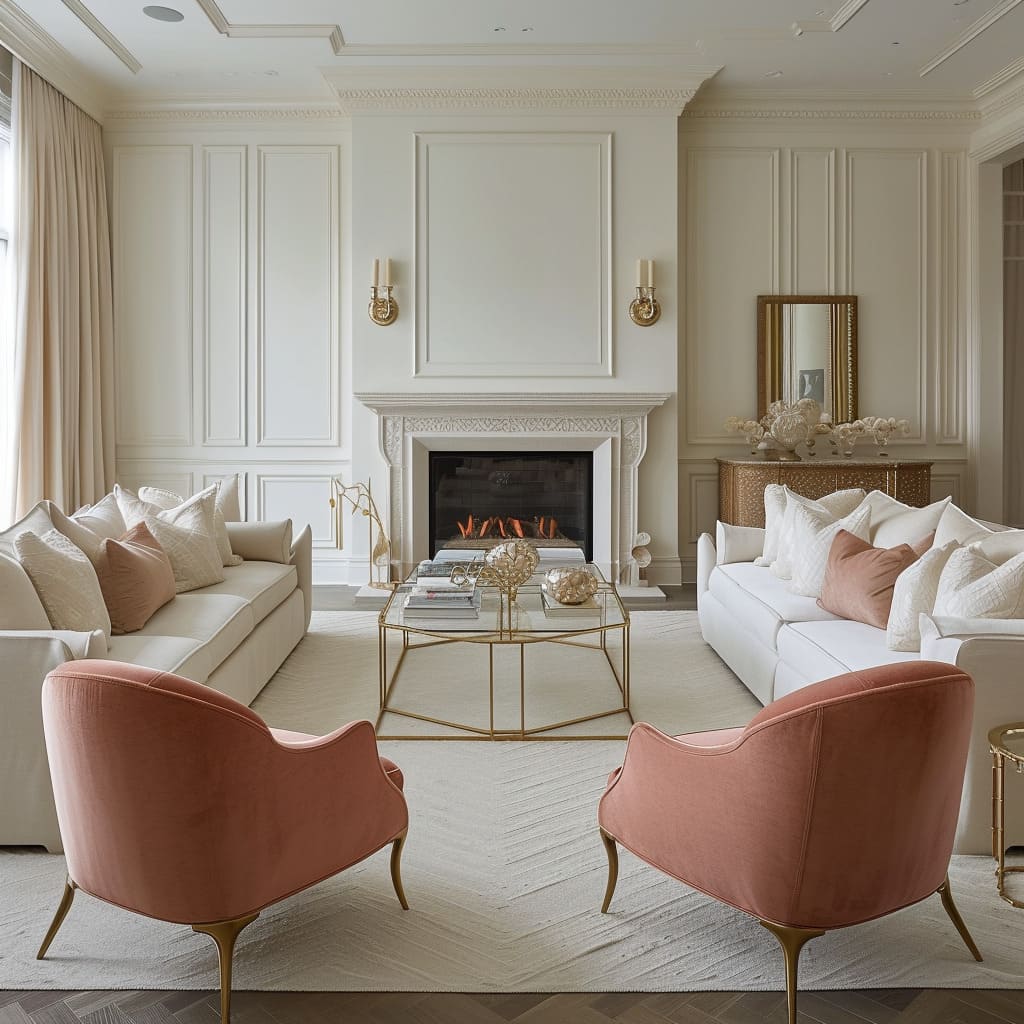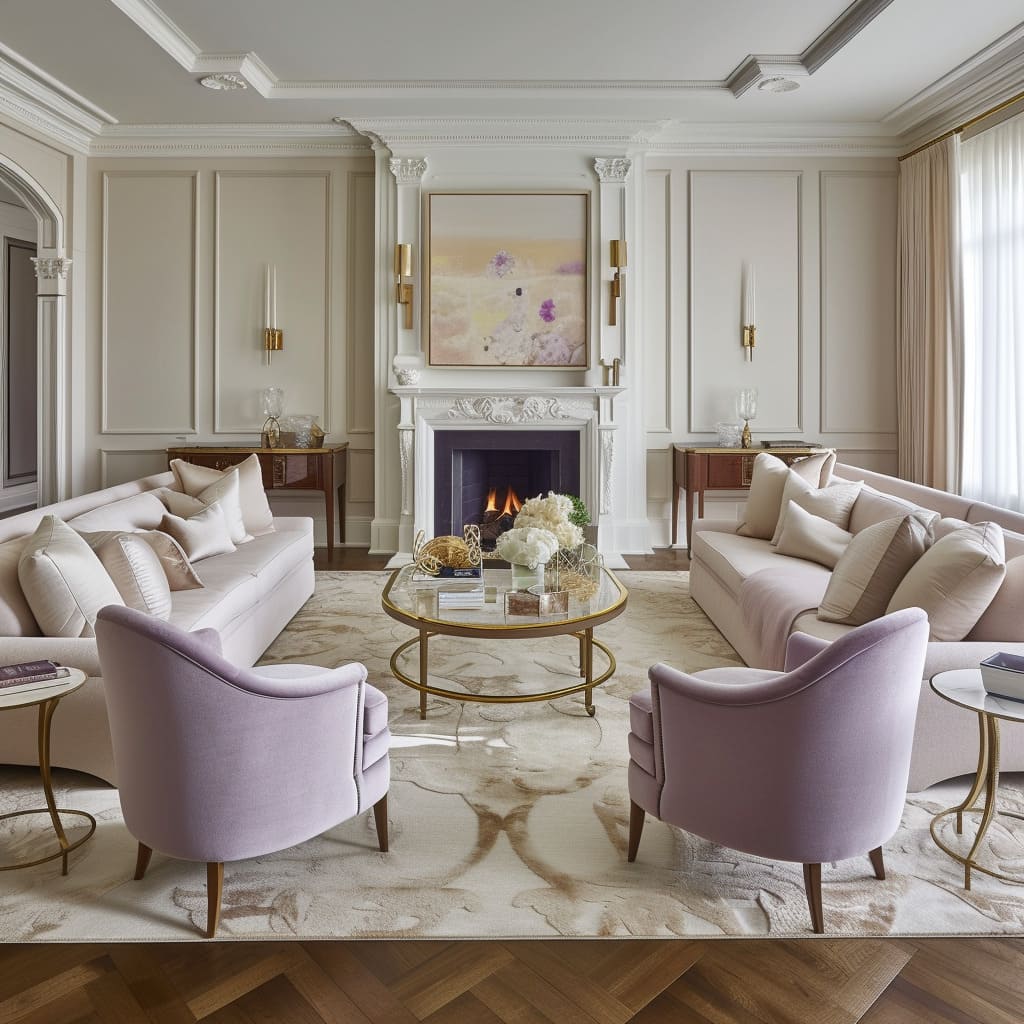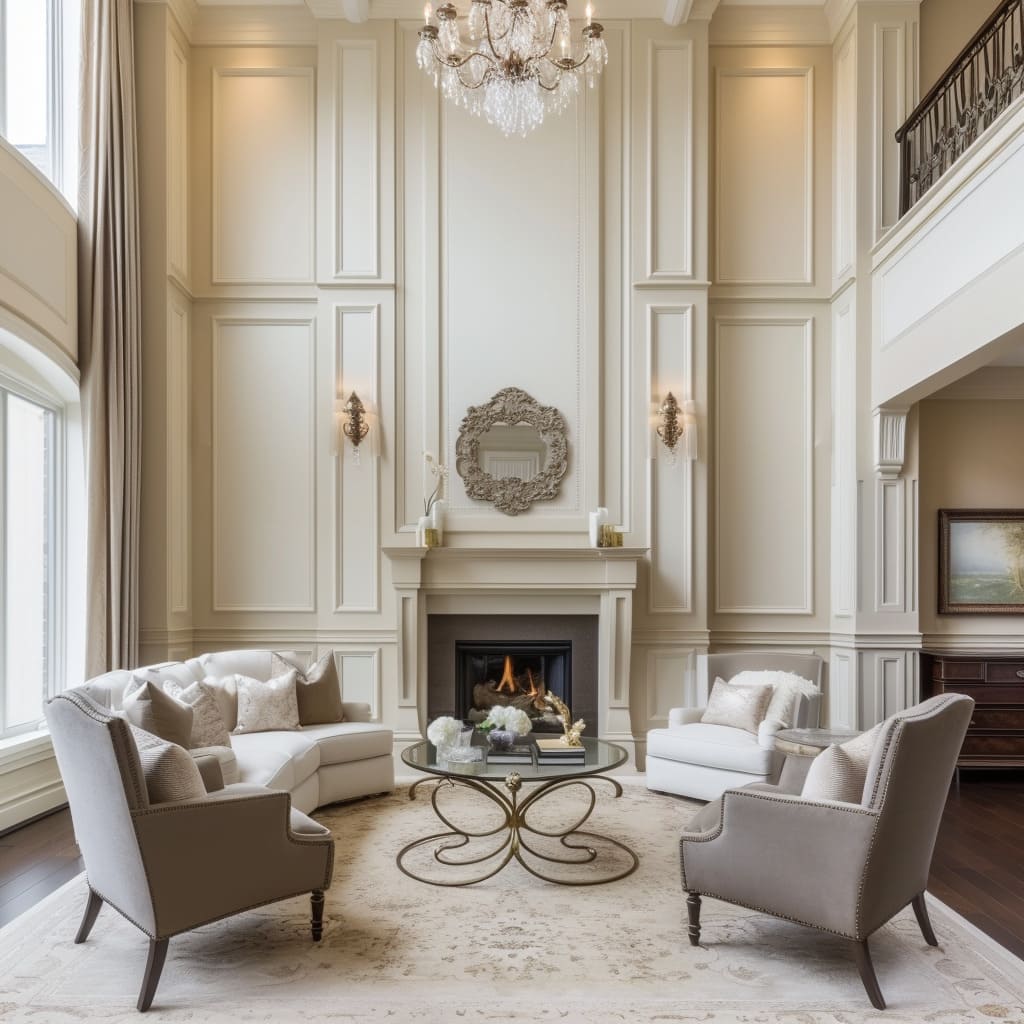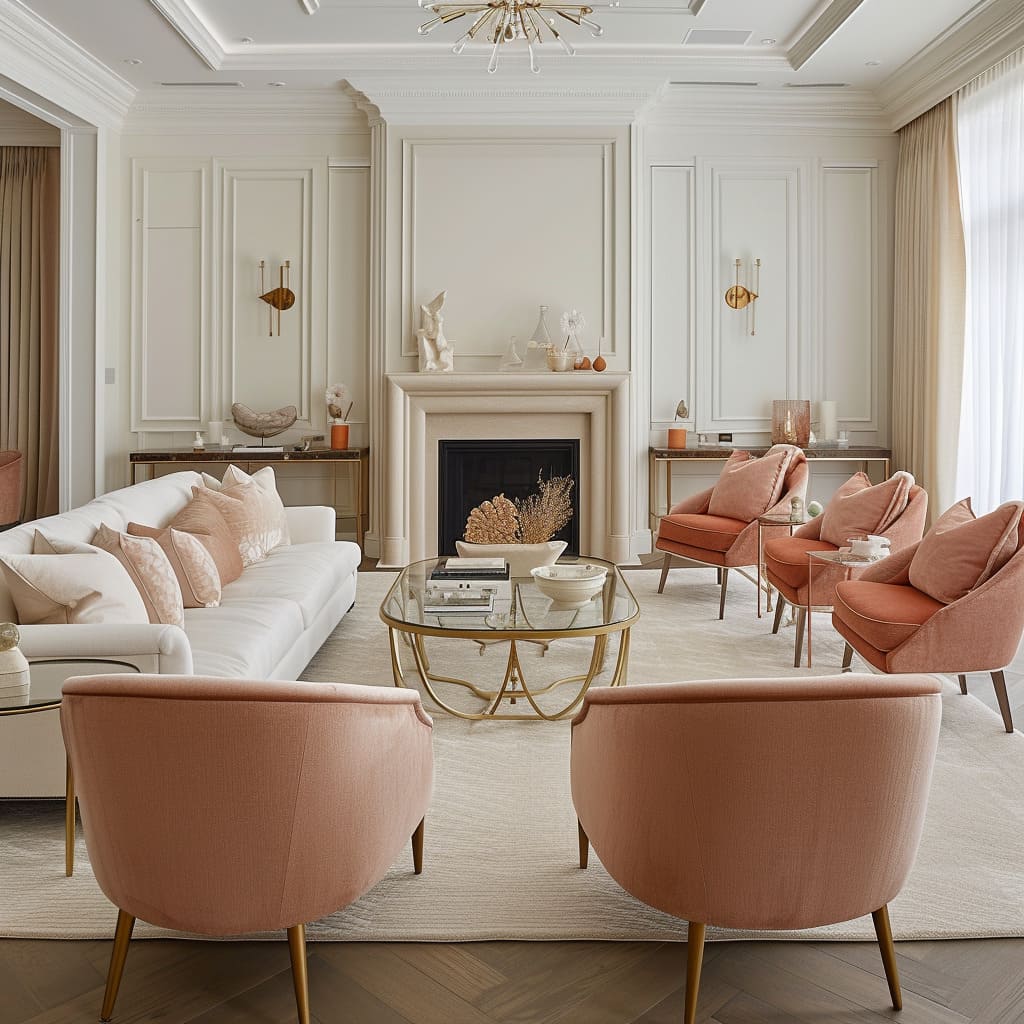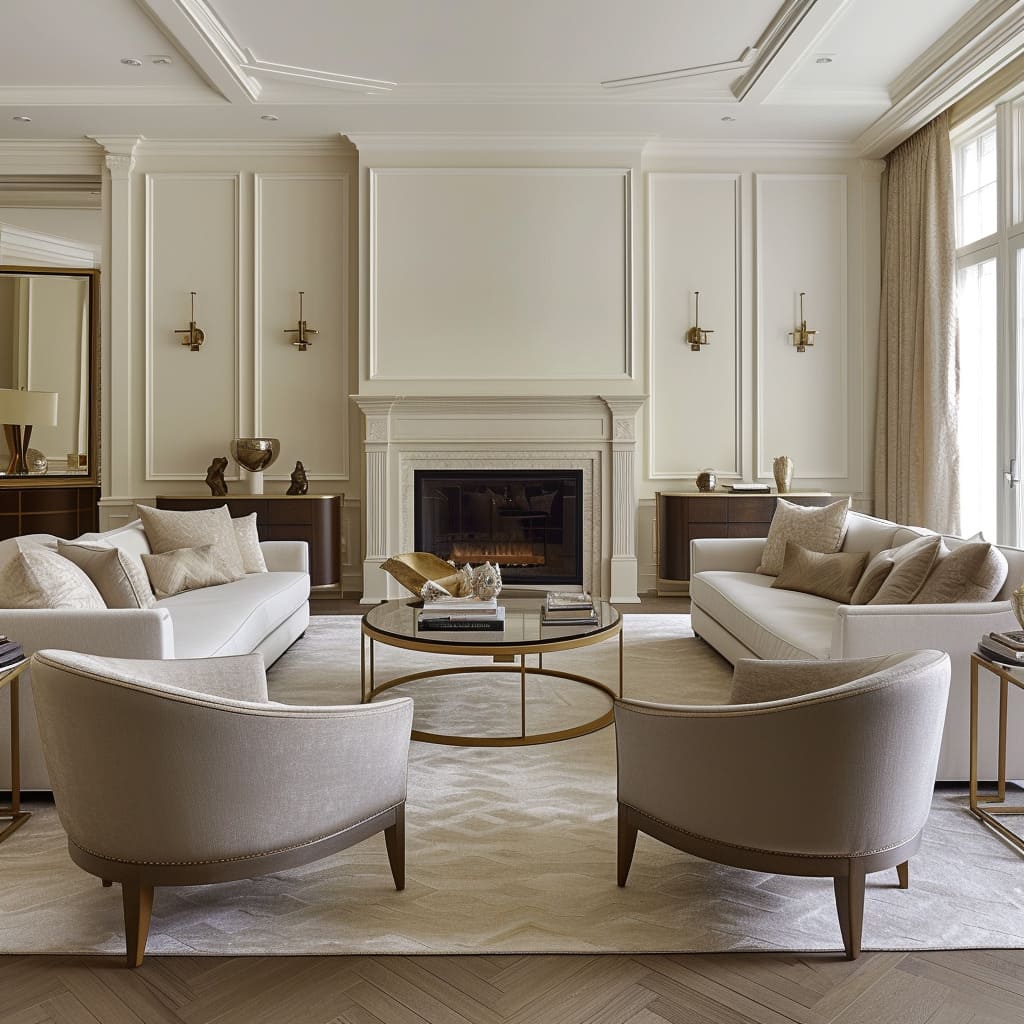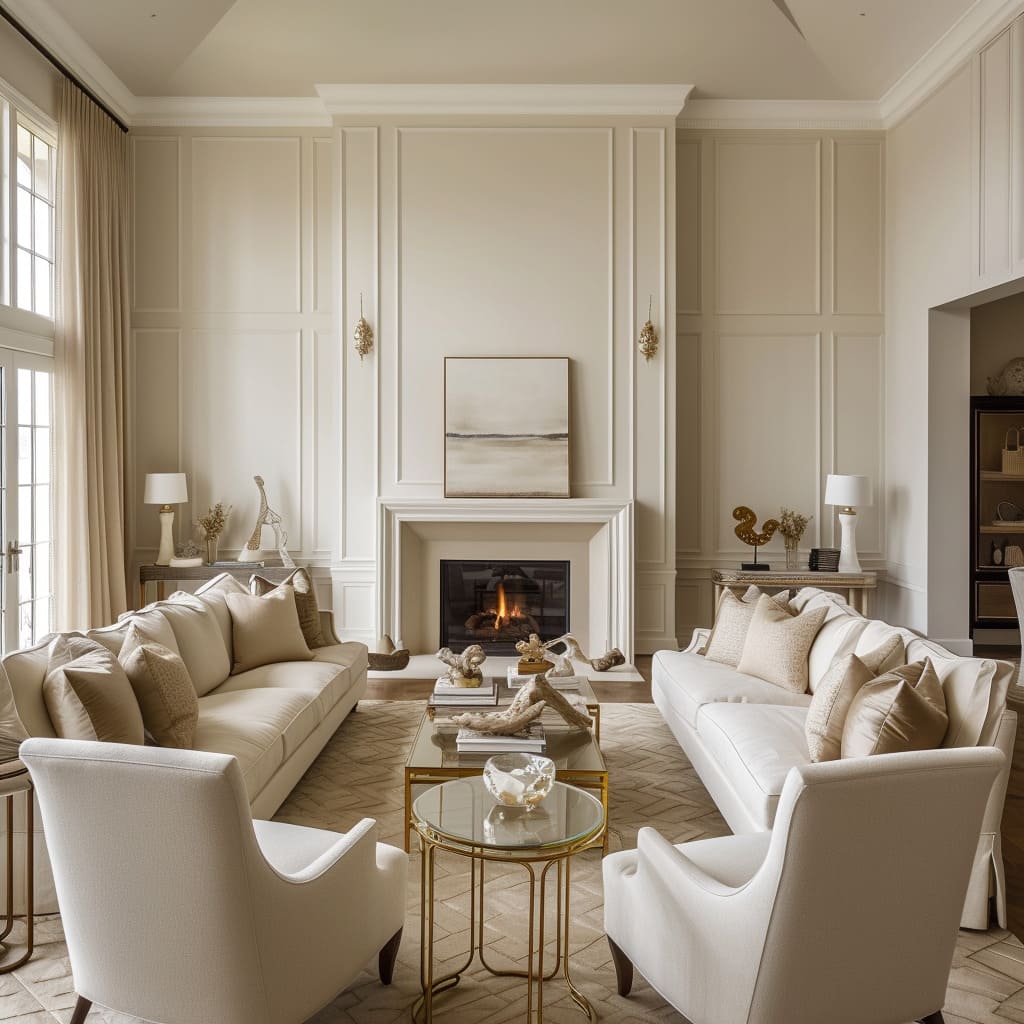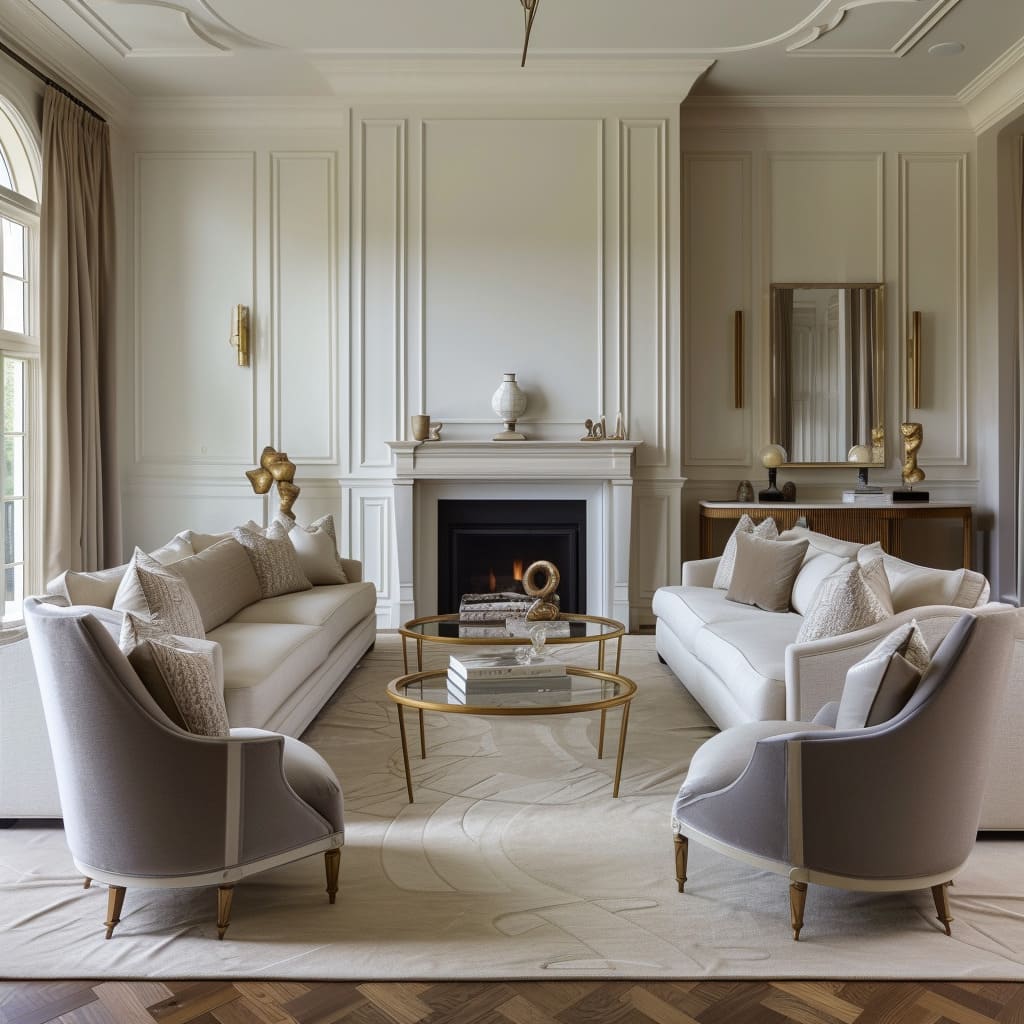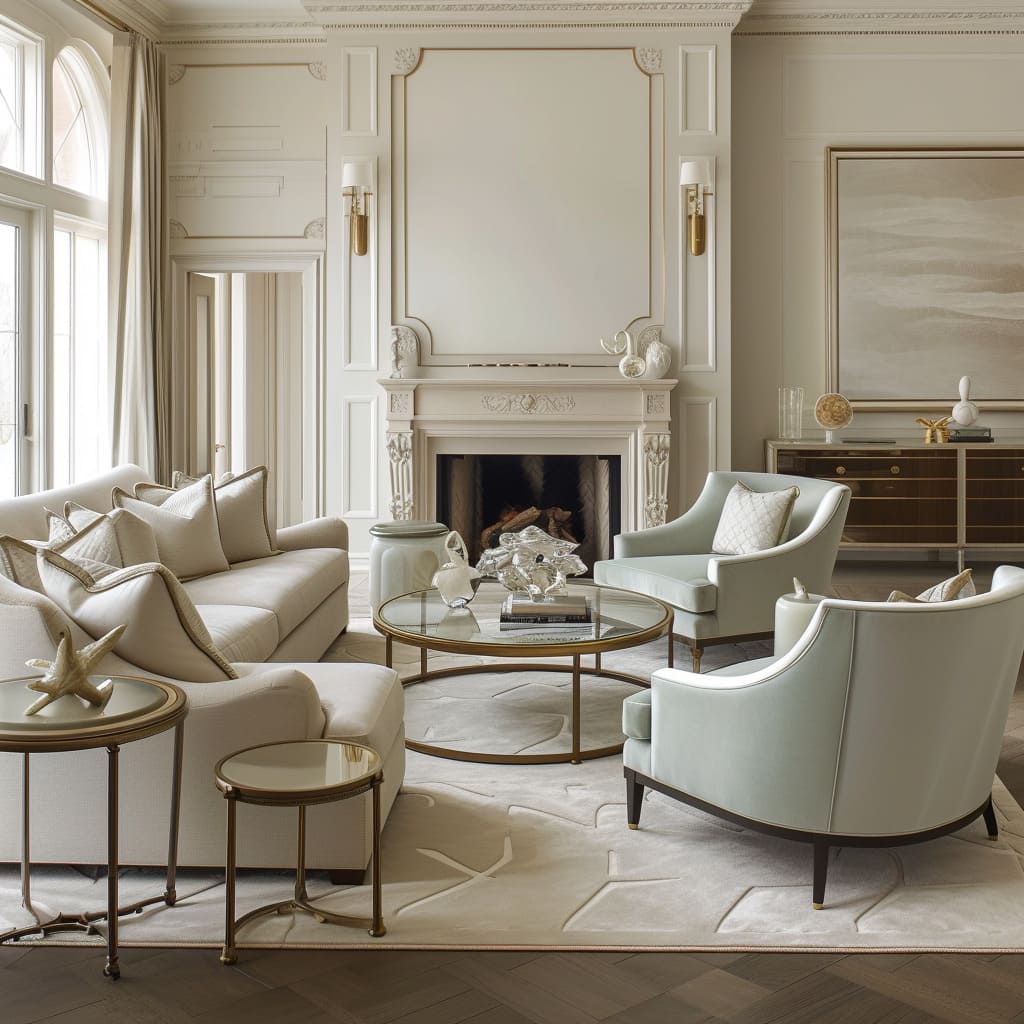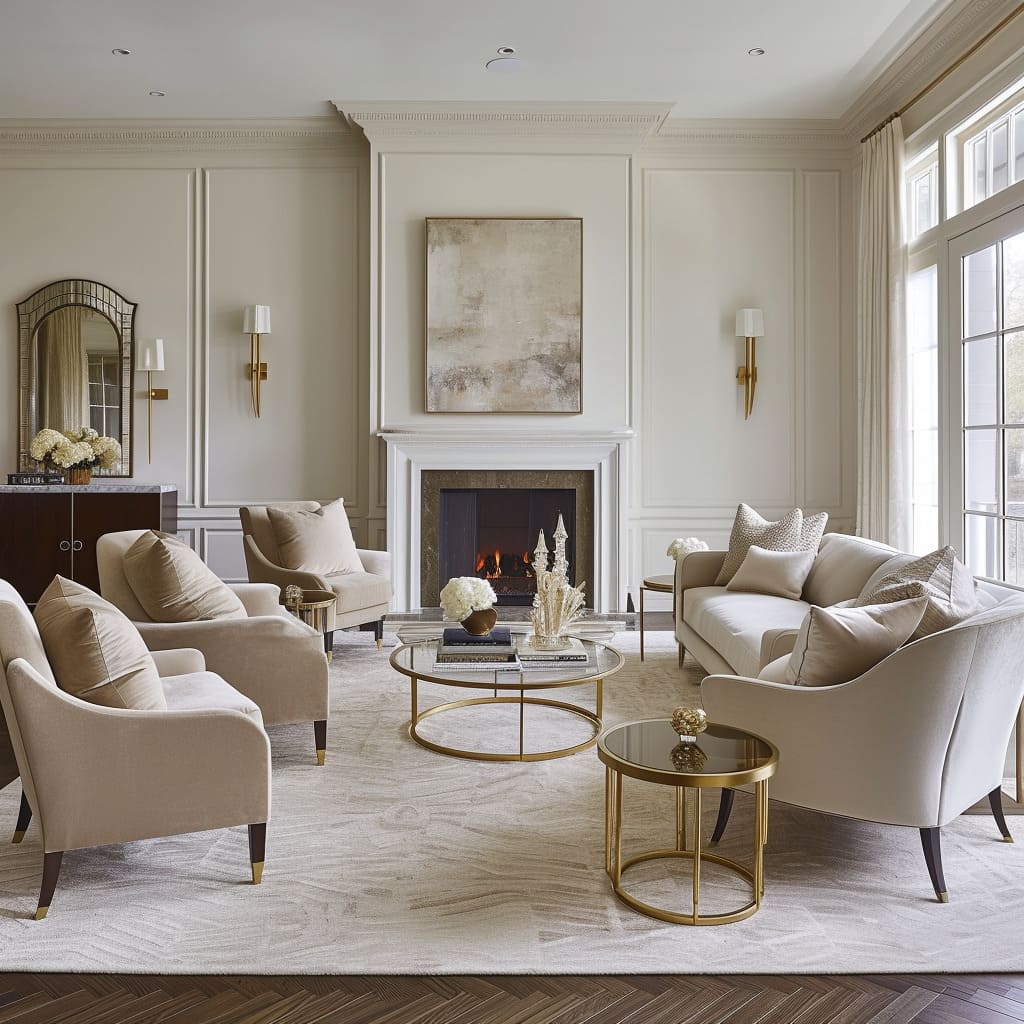This guide invites you on a visual journey through designed living spaces that blend the subtleties of a neutral color palette with the richness of high-end materials and textures. From the understated grace of elegant furniture lines to the architectural finesse of decorative molding and paneling, these interiors are curated to inspire tranquility and exude timeless charm.
We delve into the principles that make these spaces not just houses, but homes teeming with warmth, balance, and a personal touch. Whether it’s the strategic layering of lighting, the considered placement of accent decor, or the choice of art that speaks without shouting, each element is a brushstroke in the larger picture of refined living.
The interior designs of the living rooms exhibit a cohesive aesthetic that can be characterized by several key features.
Decorative Molding and Paneling
The decorative molding and paneling in these living rooms are the unsung heroes of the design, bringing an air of grandeur and craftsmanship. The crown molding enhances the height and grandiosity of the rooms, while the paneling adds depth and shadow, creating a dynamic interplay with the natural light.
These elements serve as a bridge between the furnishings and the architecture, unifying the space with a continuous visual theme that wraps around the room.
To incorporate decorative molding and paneling into your own home, start by considering the scale of your room. In a space with high ceilings, crown molding can be more elaborate, while in a room with lower ceilings, a simpler style may be more appropriate to avoid overwhelming the space.
Paneling can be applied in numerous ways — from full walls to wainscoting — and can be painted to match or contrast with the wall color. When choosing these elements, consider the historical context of your home and select styles that complement its architectural heritage.
Elegant Furniture Lines
The furniture within these spaces showcases a fusion of contemporary and classic design, providing a timeless elegance. The modern, clean lines of the sofas are softened by the gentle curves of the armchairs, which beckon one to sit and unwind.
Details such as tufting on the upholstery and tapered wooden legs add character and finesse. The pieces are carefully proportioned to fit the scale of the rooms, creating an inviting layout without overcrowding.
To implement elegant furniture lines in your own living room, seek out pieces that combine form with function. Look for sofas with straight, clean lines and pair them with chairs that feature a curved back or armrest for contrast.
Pay attention to the legs of the furniture—choosing slender, tapered designs can convey a sense of lightness and refinement. Above all, prioritize comfort, ensuring that the furniture is as inviting to use as it is beautiful to behold.
Neutral Color Palette
The living rooms display a masterful use of a neutral color palette that serves as a serene backdrop to the overall design. With walls painted in hues of cream, taupe, and pale gray, these spaces evoke a sense of peace and spaciousness.
The neutrality of the palette is skillfully broken by the occasional use of muted blues and greens in accent pieces, which provide a subtle nod to color without disrupting the tranquil scheme. The harmonious blend of these soft tones creates a canvas that allows the finer details and textures to shine.
To achieve such a color palette in your own space, focus on selecting paints with warm undertones that complement natural light. Use color swatches to test how these shades change under various lighting conditions throughout the day.
By keeping the larger surfaces neutral, you can afford to experiment with color through accessories, textiles, and art, allowing for an easy transition should your taste or design trends change.
Luxury Materials and Textures
The choice of materials in these living rooms is a testament to the luxury and quality of the design. Rich, tactile velvet on seating provides a contrast against the smooth, cool touch of marble surfaces.
Detailed grains in the dark wooden furniture add depth and natural beauty, while the reflective surfaces of brass fixtures and accessories provide a warm glow and a touch of opulence. The interplay of these textures contributes to a layered, sensory experience that is both visually and physically engaging.
Incorporating such materials and textures into your own interior requires a careful balance. Choose a statement piece in velvet for a touch of sophistication, pair it with a marble-topped coffee table or side table for a luxurious touch, and select brass lighting or hardware for a cohesive look.
Ensure that each material is given space to be appreciated individually, yet works in harmony with the whole.
Symmetry and Layout
The symmetry in these living spaces is no accident; it’s a deliberate design choice that instills a sense of balance and harmony. The strategic placement of twin armchairs flanking a fireplace, matching side tables, and identically framed artworks contributes to a well-ordered and refined aesthetic.
The symmetrical layout also guides the eye effortlessly around the room, creating a visual rhythm that is both comforting and pleasing. The arrangement encourages conversation, with furniture pieces positioned to face each other, making the space as functional as it is beautiful.
To implement symmetry in your own living room, begin with a focal point such as a fireplace or a large window and arrange your furniture in mirror image around it. Use pairs of lamps, cushions, or chairs to create a balanced look.
However, it’s important to introduce some asymmetrical elements to avoid a monotonous look — a strategically placed floor lamp or a unique piece of art can break the symmetry just enough to add interest.
Layered Lighting
The concept of layered lighting is masterfully executed in these living rooms, creating a multifaceted lighting scheme that enhances both the functionality and the aesthetics of the space. During the day, natural light pours in through generous windows, illuminating the rooms and highlighting the textures of the furnishings and the architectural details.
As evening falls, the ambient glow from strategically placed overhead fixtures, such as chandeliers with dimming capabilities, provides a soft illumination that cozies up the space. Task lighting, such as reading lamps, is introduced to provide focused light where needed, while accent lighting, including wall sconces and picture lights, draw attention to the artwork and the beautiful molding on the walls.
To replicate this layered lighting approach in your home, start by maximizing natural light with sheer window treatments. Choose a statement overhead light fixture that reflects your style and install a dimmer switch to adjust the light levels.
Incorporate a variety of light sources at different heights and for different purposes, such as table lamps for reading and wall sconces for accent lighting. Use these layers in conjunction to create the right mood for every moment, whether you’re hosting a lively gathering or settling in for a quiet evening.
Accent Decor
Accent decor is not merely an afterthought but a strategic component that infuses the rooms with character and life. Each item, from the sculptural vases on the coffee tables to the carefully curated collections on the built-in shelves, has been selected for its ability to harmonize with the space while also standing out as an object of interest.
The placement of these pieces is intentional, drawing the eye to various points around the room and creating vignettes that tell a story. The use of decorative books adds an intellectual touch, while floral arrangements bring in an element of nature and freshness.
For those looking to enhance their living space with accent decor, consider the scale and color of your room when selecting pieces. Choose items that speak to your interests and that you love to see every day.
Group smaller objects together to create a sense of collection and give individual pieces room to breathe so they can be appreciated fully. Remember, the goal is to strike a balance between personality and cohesion, ensuring that each piece feels like a part of the whole.
Artwork
The artwork in these living rooms acts as a window into the soul of the space, providing both color and contemplation. Each piece has been thoughtfully chosen to complement the room’s design, with a preference for works that project calm and tranquility, such as the soft, abstract paintings and the serene landscapes that act as gentle focal points.
The framing and matting of the artwork are as integral to the design as the art itself, with frames that enhance the work without overwhelming it. The placement of the artwork is strategic, hung at eye level to engage the viewer and to integrate seamlessly with the scale of the furnishings.
To incorporate artwork into your own space, select pieces that resonate with you personally. Consider the existing color scheme and style of your room when choosing art to ensure that it enhances rather than clashes with your decor.
Pay attention to framing, choosing a style that complements both the artwork and your interior design. Hang pieces at the appropriate height and don’t be afraid to use larger works as statement pieces on expansive walls.
Art is an expression of your taste, so let it reflect your personality.
Area Rugs
In the living room designs presented in this article, area rugs play a critical role, not just in defining the seating areas, but also in enhancing the overall sense of luxury and comfort. The textures of the rugs range from plush velvets to soft wools, providing a tactile contrast to the smooth flooring beneath.
The patterns are selected with subtlety in mind, often featuring muted geometric designs or gentle waves that add an artistic touch without overwhelming the space. The colors of the rugs echo the room’s neutral palette, which helps to seamlessly integrate them into the environment.
To incorporate similar area rugs into your own interior, consider the size and scale of your room. Choose a rug that is large enough to fit under the main pieces of furniture, which will help to unify the seating area.
Look for rugs with a low-pile or flat-weave in neutral colors to maintain a sophisticated look, and opt for subtle patterns that complement rather than compete with the rest of your decor. Remember, the rug should act as the foundation of your space, setting a cozy and inviting stage for the rest of your furnishings.
Attention to Detail
The curated living rooms showcase a remarkable attention to detail that gives each space its unique character and polished finish. This is evident in the bespoke nature of the decorative elements, from the hand-picked cushions with their piped edges and textured fabrics to the artfully arranged books that not only entertain but also serve as design elements.
The accessories, whether vases or sculptural pieces, are not randomly placed but are chosen for their ability to enhance the color scheme and contribute to the narrative of the space.
To achieve this level of detail in your own home, focus on selecting accessories that reflect your personal style and complement the room’s design. When arranging items on a coffee table or shelf, group them in odd numbers to create a more natural and aesthetically pleasing display.
Consider the scale and color of each item to ensure they contribute to a cohesive look. It’s the small touches, like the way throw pillows are fluffed or the symmetry of candlesticks on a mantelpiece, that can make a room feel thoughtfully composed and complete.


